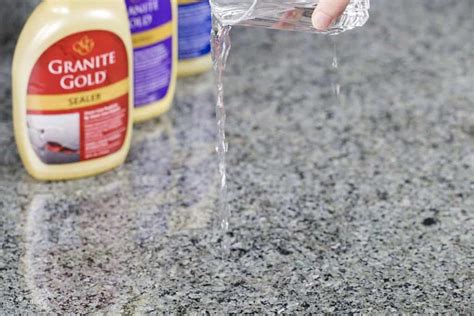How To Tell If Your Granite Is Sealed
Ronan Farrow
Mar 20, 2025 · 3 min read

Table of Contents
How to Tell if Your Granite is Sealed: A Comprehensive Guide
Granite countertops are a luxurious and durable addition to any home. However, to maintain their beauty and longevity, proper sealing is crucial. Knowing whether your granite is sealed, and how effectively, is key to preventing staining and damage. This comprehensive guide will teach you how to determine if your granite is sealed and what to do if it isn't.
Understanding Granite Sealing
Granite is a naturally porous stone. This means it has tiny holes that can absorb liquids, leading to staining and damage over time. Sealing creates a protective barrier, preventing liquids from penetrating the stone's surface. A properly sealed granite countertop will repel water and other liquids.
Methods to Check for Granite Seal
Several methods can help you determine the sealing status of your granite countertops:
1. The Water Test: The Most Common Method
This is the simplest and most widely used method. Simply place a few drops of water on your granite countertop.
- If the water beads up and sits on the surface, your granite is likely sealed. The water should remain largely intact for several minutes.
- If the water is immediately absorbed, your granite is likely unsealed or needs resealing. The water will soak into the stone quickly, leaving a dark, damp spot.
Important Note: This test should be conducted on a clean, dry surface away from direct sunlight.
2. The Vinegar Test: A More In-Depth Check
While the water test provides a quick assessment, the vinegar test offers a more thorough evaluation of your granite's seal.
- Apply a small amount of white vinegar to an inconspicuous area of your countertop. Let it sit for a few minutes.
- If the vinegar beads up, your granite is properly sealed.
- If the vinegar is absorbed and a reaction occurs (fizzing or discoloration), your sealant might be failing or your granite is unsealed. This suggests the sealant is no longer effective and needs to be reapplied.
Caution: Always test in an inconspicuous area to avoid potential damage or discoloration.
3. Inspect for Wear and Tear: Visual Clues
A close visual inspection can also reveal clues about the effectiveness of your granite's sealant.
- Look for any stains or discoloration. These are strong indicators that the sealant has failed or wasn't applied properly.
- Check for dullness or a lack of shine. A properly sealed granite countertop will generally have a more vibrant and polished appearance.
- Feel for any roughness or porous texture. Sealed granite should feel smooth to the touch.
What to Do if Your Granite Isn't Sealed
If your tests indicate that your granite is not sealed or that the sealant is failing, it’s time to take action. Resealing your granite is a straightforward process that can be done by a professional or a skilled DIY enthusiast.
- Cleaning is crucial before resealing. Thoroughly clean your granite to remove any dirt, grime, or existing sealant.
- Choose a high-quality granite sealant. Look for sealants specifically designed for granite countertops.
- Follow the sealant manufacturer's instructions carefully. This ensures proper application and optimal results.
Maintaining Your Sealed Granite
Regular maintenance is key to preserving the beauty and longevity of your sealed granite countertops. This includes:
- Wiping up spills promptly. This prevents liquids from penetrating the granite and causing staining.
- Using a pH-neutral cleaner. Harsh cleaners can damage the sealant over time.
- Resealing periodically. Even with proper maintenance, sealant effectiveness will eventually diminish, requiring periodic reapplication (typically every 1-3 years, depending on usage).
By following these tips, you can ensure that your granite countertops remain beautiful and protected for years to come. Remember, regular checks and proactive maintenance are essential for keeping your granite in top condition.
Featured Posts
Also read the following articles
| Article Title | Date |
|---|---|
| How Do You Winterize A Swamp Cooler | Mar 20, 2025 |
| How To Wire A Relay For A Horn | Mar 20, 2025 |
| How To Wire Fuel Pump To Ignition Switch | Mar 20, 2025 |
| How Do You Get A Legal Separation In Florida | Mar 20, 2025 |
| How Do You Paint Thermofoil Cabinets | Mar 20, 2025 |
Latest Posts
Thank you for visiting our website which covers about How To Tell If Your Granite Is Sealed . We hope the information provided has been useful to you. Feel free to contact us if you have any questions or need further assistance. See you next time and don't miss to bookmark.
